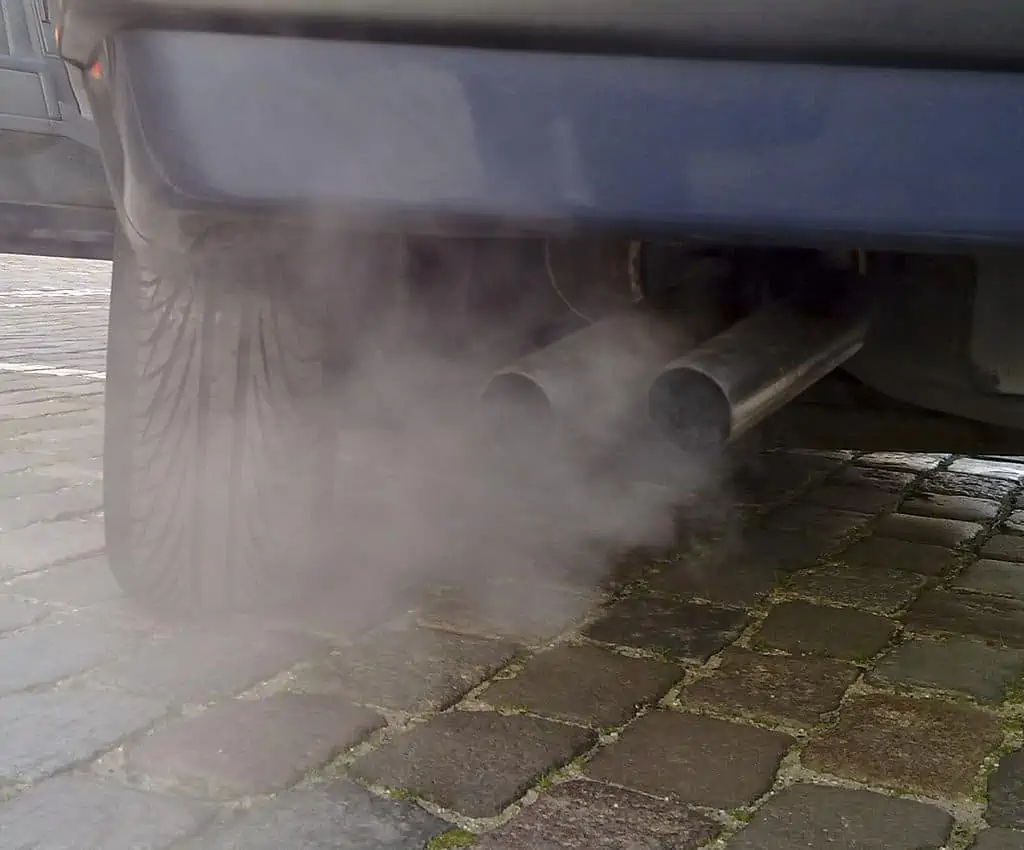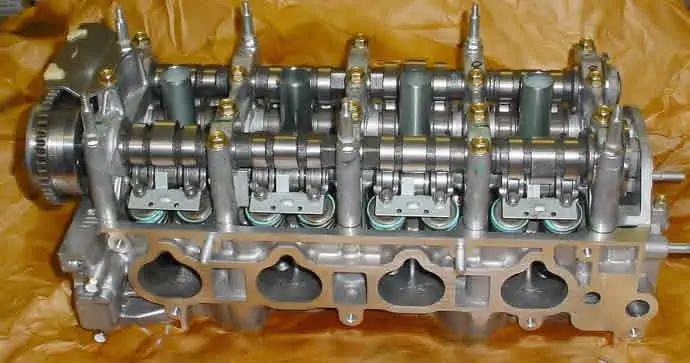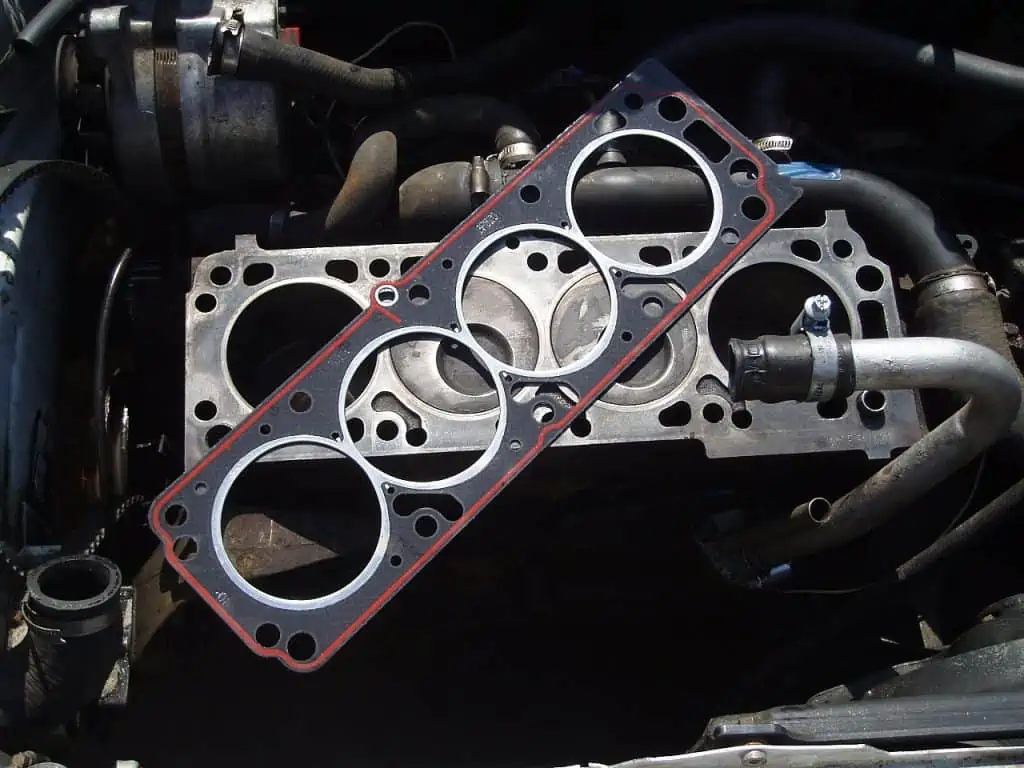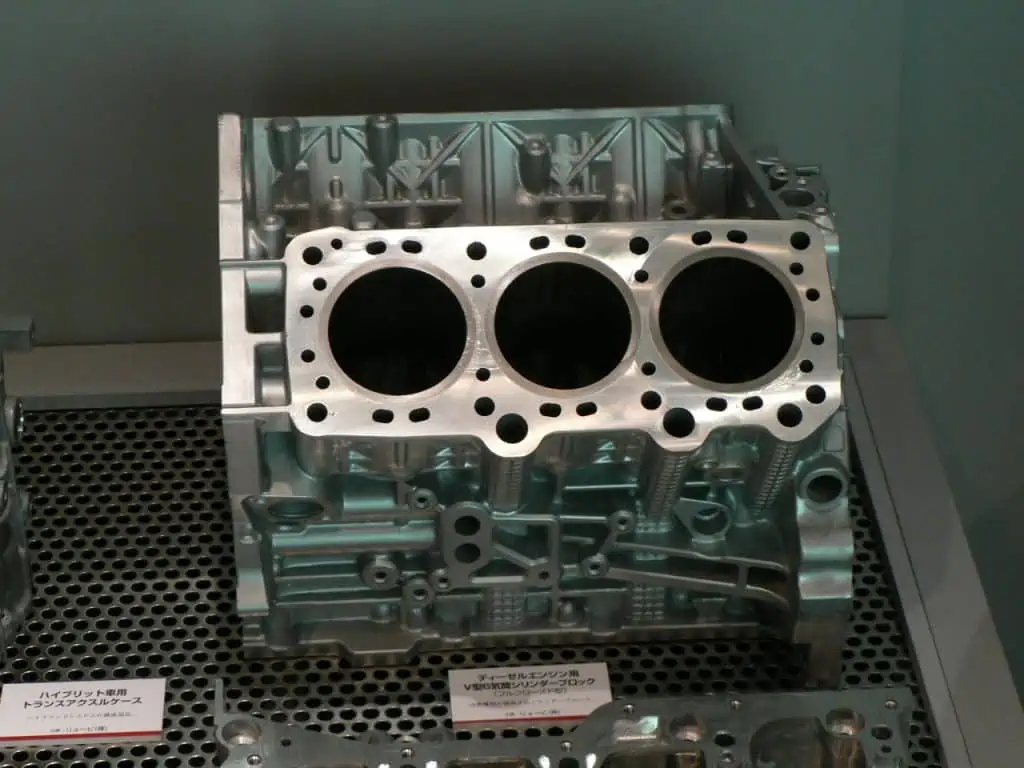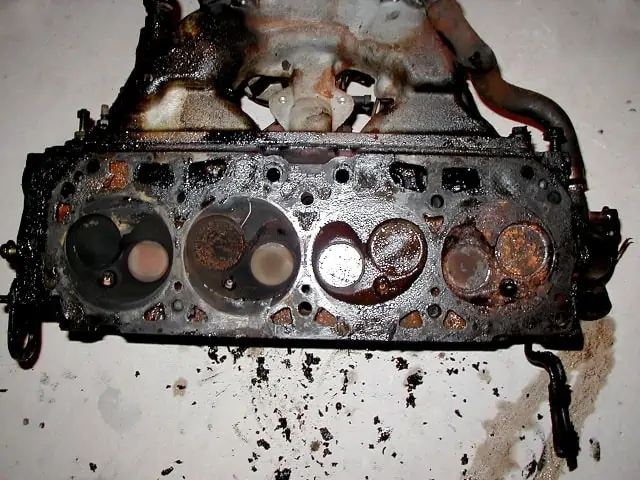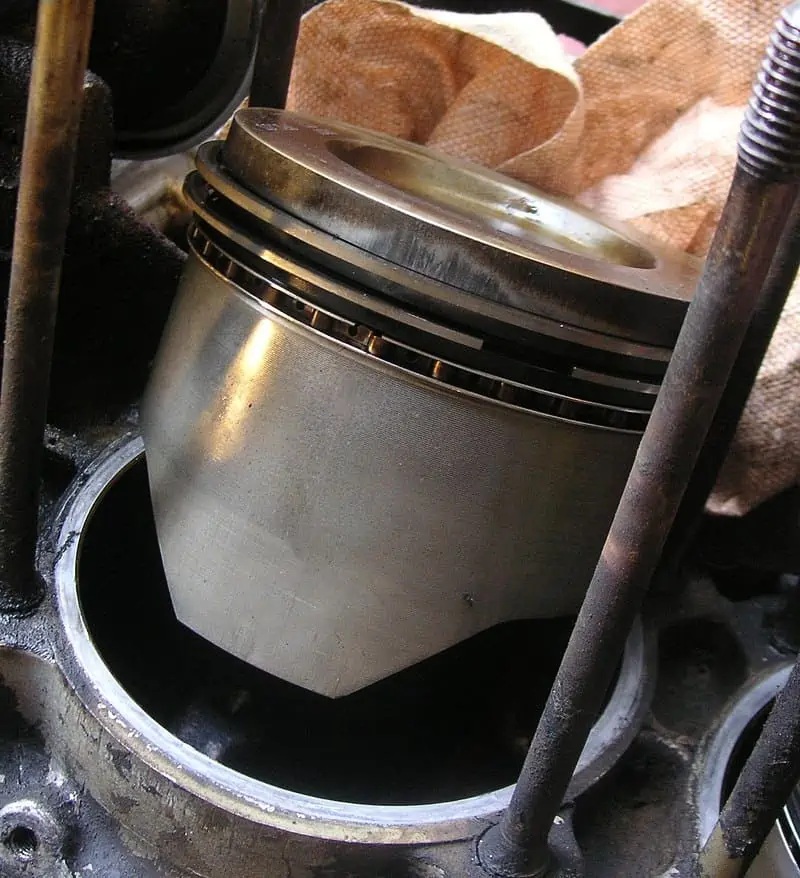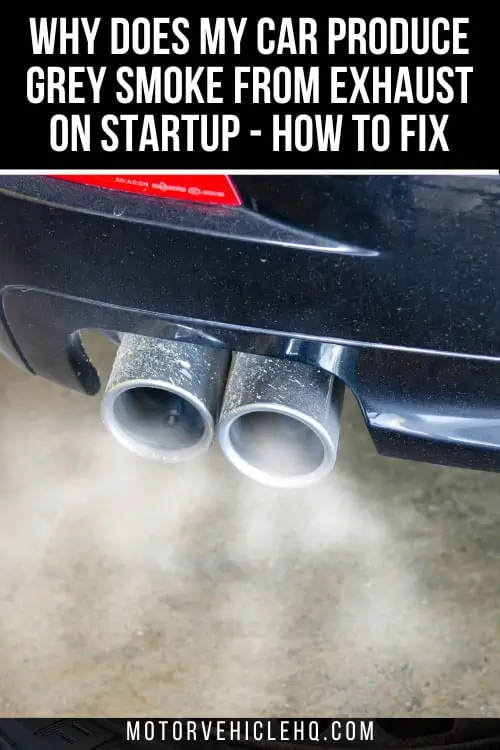The purpose of your car’s exhaust system is to direct gases away from the internal combustion process within your engine, preventing the engine from being loaded with burnt fuel or burnt vapors, which would increase friction and cause overheating.
If anything isn’t operating correctly or strange-colored smoke is emerging from the exhaust when it starts up, you should fix it right away.
No vehicle owner wants to experience the hours of dread when their vehicle starts to emit grey smoke from exhaust on startup. However, this fume problem marked the beginning of many stories about replacing and repairing engines and engine parts.
While the grey smoke coming from your car’s tailpipe occasionally goes unnoticed. However, there are a few circumstances in which you might wish to focus on the actual issue.
Grey exhaust smoke is not a good indication. Any other hue of smoke than thin grey or anything extremely light that resembles water vapor coming from a car’s exhaust is a clue that there is a problem.
This issue is directly tied to the engine’s combustion system and might be harmful if not resolved right away.
In the meanwhile, let’s investigate the potential causes of grey smoke coming from a car’s exhaust and the best method to resolve the situation before it worsens.
Knowing When Grey Smoke from Exhaust on Startup Is a Big Problem
When identifying and resolving the engine issue, understanding what is normal and what requires attention is equally crucial.
Grey smoke from the exhaust by Ruben de Rijcke / CC BY-SA 3.0. You may tell the engine is suffering an internal issue when grey smoke starts to come out of the exhaust tailpipe.
While you may see that thin, vanishing smoke is typical throughout the winter, you may want to take action if you see thick, heavy smoke on hotter days. Another issue arises when you notice further signs of an engine component failure, such as a burned smell and declining engine power.
What Causes Grey Smoke from Exhaust on Startup?
Nobody likes to start their car and then see strangely colored exhaust emissions as soon as the engine is starting. There are a few possible causes of this probe if it happens to your gas-powered vehicle when you turn the key in the ignition and detect grey smoke coming from the exhaust.
Some of the causes of this are trivial, and they may be quickly and painlessly remedied. Grey smoke from exhaust on startup can also be caused by several other, much more dangerous factors that could eventually cause additional problems.
1. Buildup As a Result of Condensation
When you turn on your vehicle, not all of the grey smoke is a sign of problems. When you see fine, grey smoke at starting that quickly goes away, you know condensation buildup has occurred.
Your car’s engine warms up when you turn it on. Heat causes condensation, which results in willowy, grey smoke that quickly dissipates. When this smoke persists for more than a few minutes, it should be taken seriously. You might need to do a check if you observe that the grey smoke is slithering out virtually continually.
It is also important to note that this is a typical scenario in nations with chilly weather. Thick grey smoke is an indication of engine damage if the location you reside in is hot and humid or has higher temperatures.
Your vehicle could have internal problems in such circumstances.
2. Leakage of Coolant
What stops the engine of your vehicle from just melting away the nearby pipes when it gets too hot? It is the coolant system in your vehicle.
It safeguards not only the engine from overheating problems but also other components like the head gasket from potential harm.
The coolant, which you might be familiar with as antifreeze, transfers the built-up heat through it. Keeping the engine at a healthy and safe temperature is also important.
These glycol-based coolants’ leaks, corrosion, and malfunction have long been the cause of serious engine failure in cars. Similarly, one of the issues that arise when there is a leak or damage to the coolant is grey smoke when your vehicle starts up.
Fortunately for you, there are a few more signs to look for in addition to the grey smoke coming from the exhaust to determine whether the antifreeze is the true culprit.
You could have a coolant leak into the engine, which will lead to a heating issue if you observe that the coolant reservoir is running on low and the smell of the grey smoke is slightly pleasant.
It is essential to patch the leak as soon as possible if you discover all three signs that the grey smoke is being produced by coolant damage. Otherwise, the leak might contaminate the engine oil, which would result in more harm.
According to UTI, depending on the type of vehicle, the coolant should be replaced every 5,000 to 10,000 miles to maintain its effectiveness.
Car cylinder head by Kauczuk / CC BY-SA 3.0. When the engine’s antifreeze system fails, the engine rapidly overheats. This surge and fall in temperature cause the cylinder head to expand and shrink inexplicably.
Now, the following factors may contribute to grey smoke coming from the exhaust when the engine first starts and links to a coolant leak.
3. A Defective Cylinder Head
Overheating can be a serious issue if your car’s exhaust is spewing out dense grey smoke when you start it for prolonged periods. Such a problem is associated with coolant failure or leakage, which is often brought on by a damaged cylinder head.
Rapid overheating occurs when the engine’s antifreeze system malfunctions. Most of the time, the overheating will also finally swiftly cool down. The cylinder head expands and contracts unpredictably as a result of this rise and decrease in temperature.
Cast iron, aluminum, or a combination of the two cylinder heads are especially prone to this. Stress results, causing everything from an overheated central core to a cylinder head break.
If the head is broken or damaged, the likelihood of the coolant liquid entering other cylinders or sections of the engine becomes imminent. There are situations when a leak may even enter the combustion chamber if it persists for a prolonged period, such as overnight. As a result, the coolant would entirely burn out, emitting grey smoke as the engine started.
4. A Damaged Head Gasket
Your engine suffers the most harm when the internal combustion engine in your vehicle is damaged. The car’s exhaust pipe notably sent forth grey smoke due to a burst head gasket in this instance.
The main reason for this is that neither the driver nor the passengers can immediately tell that the head gasket of the vehicle has been damaged. It takes a few kilometers of driving before you see seething grey smoke coming from your front hood.
The performance of a head gasket, which is a component of the car’s internal combustion system, has a significant impact on how well your car’s engine runs. Being a clocking seal for the cylinder’s firing pressure and between an engine block is an essential part of a head gasket’s job.
Additionally, it prevents any leaked oil from getting into other components. In other words, it is in charge of controlling the enormous pressure that develops.
Damaged or leaking head gaskets are referred to as “blown” head gaskets. One of the numerous indicators that a head gasket needs to be repaired is the grey smoke coming from the exhaust tailpipe. Along with it, you could also notice an unexpected coolant leak, a bubbling reservoir tank, and an oil hue that resembles milk.
Additionally, you can notice a suggestible decline in the power system of your engine. If this happens, you might wish to get in touch with a specialist right once.
5. An Engine Block That Splitters
When grey smoke starts to emerge from your exhaust tailpipe, you know the engine is having an internal problem. A broken engine block is another scenario in which a coolant leak might result in grey smoke dispersing upon restart. A split engine block is difficult and expensive to replace in comparison to other parts.
More signs might help you determine whether the engine block is overheated and damaged in addition to the obvious grey smoke.
It should serve as sufficient notice that your engine block may have been compromised if you check your coolant and find that it is either frozen or discolored.
The performance of the engine also shows a trickle, and you may see fluid under your vehicle.
Car head gasket by Collard / CC BY-SA 3.0. The efficiency with which your car’s engine operates is directly related to how well a head gasket, a part of the internal combustion system, performs.
6. Deficiencies with the Fuel Injector
Fuel is pumped into the engine of a vehicle using fuel injectors, which include valves that are electronically regulated. Diesel-powered vehicles are particularly affected by this issue. You may want to check the fuel injector’s condition if your diesel car is emitting grey smoke from the hood.
During the spray injection, the cylinder pressure and ignition timing must both be regulated properly. Due to the importance of the time utilized to spray the diesel into the cylinder, a discrepancy in this timing might cause the injection to malfunction.
In turn, the engine would have to work too hard in too little time, resulting in the gasoline going unburned during starting. As a result, you would immediately see grey smoke coming from the exhaust.
7. Piston Ring Damage and Valve Seal Leakage
Color-coded valve seals in a vehicle’s engine can function as a lock and key for any opening and shutting mechanisms. grey smoke coming from the exhaust might be a serious symptom of bad valve seals. These seals regulate the amount that should be allowed into the combustion chambers, pressure, and the oil and air combination.
You may detect a lot of grey smoke with a blueish tint when the valve seal leaks or degrades after being unaltered for a long period. You could see how the smoke rises swiftly and lingers for a long time after starting the engine. Grey smoke from a broken valve seal can be substantial, even if it would eventually go away.
Similar to this, the internal combustion engine in your vehicle has a piston ring linked to the outside piston that serves as another seal. When starting up, any leak or damage to these rings may result in the same grey smoke coming from the exhaust.
8. Incorrect Transmission Fluid Level
The correct operation of the remainder of the combustion system in your car’s engine might be upset by too much or too little transmission fluid.
When starting up, this may result in grey exhaust smoke. Along with grey smoke, a burned smell might also be a symptom of problems with the transmission fluid.
The oil or fluid will burn totally if your vehicle engine takes in more than it should through the hose. You would notice an intense burning scent at that point.
How Can You Diagnose the Grey Smoke from Exhaust on Startup?
There is a fix for every issue that causes grey smoke to come from the exhaust on startup. The majority of fixes include just tightening the nuts and making repairs, depending on what initially caused the fuming.
However, some would cost more and take more time. While you can repair a few problems on your own, more complicated ones may need expert repair personnel.
Step 1: Examine the Colour and the Level of Coolant
The engine’s coolant system’s malfunctions are one of the main reasons for a potential grey smoke emission. This is the reason why auto experts and manufacturers are always extolling the virtues of periodic coolant flushing and replacement.
You’d be able to open the hood and identify the precise issue if you were familiar with some of the components of a vehicle engine. Never forget to wait until the engine has cooled before opening the hood. Never touch the tank cap or the radiator cap while attempting to determine whether the coolant is at the proper levels.
Car engine block by 160SX / CC BY-SA 3.0. Coolant issues may be the cause of a diesel-powered vehicle’s potential to emit grey smoke from the hood. The fluid transmission may become unstable due to the engine block, the cylinder head, or coolant leaks brought on by damaged head gaskets.
It could be dangerous for you to touch either of them. To determine whether the coolant levels are too low, use a stick. If so, you would need to add extra cooling liquid to the reservoir. Every 30 000 miles, a coolant flush is advised because it checks for pollution, leaks, potential acidic antifreeze, and rust.
Step 2: Examine the Head Gasket and the Exhaust Manifold
What your lungs are to your body, the intake manifold is to your vehicle. In a nutshell, the intake manifold gasket serves as the engine’s air intake.
Check for cracks and tarnishing on the inlet manifold gasket before doing your required head gasket inspection. Because the intake is often constructed of rubber or, in some cases, plastic, you may anticipate that it will distort.
You can do it yourself to save money on the $100 to $500 it can cost to replace your intake manifold gasket.
You might then examine the head gasket after that. From scorching of the hood to grey smoke from exhaust on startup, each indicator is a signal that your head gasket seal may have been breached. In that scenario, a crack or displacement would be apparent to the naked eye.
Like engine blocks, replacing a head gasket may cost up to $2,000 but would still be less expensive than the expense of repairing the component.
Step 3: Examine the Engine Block and Cylinder Head
The cylinder head should also be thoroughly inspected to see whether it has shut down and the engine has become stuck.
Since aluminum makes up the majority of cylinder heads, a sudden temperature change can cause the cylinder to deform and finally shatter. Repairing a cylinder head may cost up to $1000, while replacing one can cost up to $3500, depending on its material.
The cost of labor makes up the majority of the expenditures involved in changing a cylinder head. This replacement is a pricey repair job if you own a premium vehicle and reside in a location where labor costs are greater.
The following techniques can be used to fix an engine block crack: cold metal patching, crack welding, and cold metal stitching. Depending on the engine design of your vehicle, fixing an engine block might take a long time and cost up to $5000.
You might be shocked to learn that switching out a smaller engine block will save you anywhere between $1000 and $1500.
Step 4: Examine the Piston Ring, the Valve, and the Fuel Injector
After that, thoroughly inspect the fuel injector. You might check to see whether it needs replacing, fixing, or maintaining. The injector aperture may occasionally get blocked, filthy, and start to exhibit abnormalities.
You might wish to remove the muck if the problem is carbon buildup and clog creation. However, you might choose to replace the injector right away if you see no blockage or muck buildup.
Next, examine the valves and piston rings. You might wish to keep in mind that the engine must be completely disassembled to inspect these little components. This is precisely why, even though it would be expensive, it is suggested that you let a qualified technician handle the dismantling.
The most expensive and time-consuming to replace among the three is a piston ring.
Fuel injectors on the engine by Buschtrommler / CC BY-SA 3.0. Examine the fuel injector in detail when analyzing engine grey smoke. You might examine it to determine whether it needs to be fixed, replaced, or maintained. On rare occasions, the injector aperture may become clogged, dirty, and manifest irregularities.
How Much Does It Cost to Fix Grey Smoke from Exhaust on Startup?
It’s advisable to fix your car’s exhaust as soon as you see grey smoke coming from it. Compared to the expense of replacing a car’s engine, the problem may be fixed for a reasonable price. Therefore, fixing the problem would be preferable to running the risk of total engine destruction.
The part will probably cost about $80, and labor will probably run you about $300. This price is only an estimate, though. It might be a bit less or a little more depending on where you live, the auto parts dealer, and the mechanic who is addressing the issue.
Grey Smoke from Exhaust on Startup: The Gas Engine Vs. The Diesel Engine
Each of the factors we listed that contribute to grey smoke pouring from the exhaust when you start your vehicle is particular to the engine type in your car. The reasons for this grey smoke in diesel-powered vehicles differ from those in gas-powered vehicles.
The chance that grey smoke would escape the bonnet of a diesel-powered car might be brought on by coolant problems. The engine block, cylinder head, or leaking coolant caused by faulty head gaskets might cause the fluid transmission to become unstable. It may also occur as a result of the fluid entering the engine’s combustion chambers.
Failures of the injection and valve systems are a key factor in why there may be smoky exhaust gases when starting gas or petrol engines. Similar problems might be anticipated, including moisture, a possibly overheated engine, and fuel pump failure.
Grey Smoke from Exhaust on Startup: Insufficient Oil or Oil Replacement
Although a low oil level in your engine won’t immediately cause grey smoke to emanate from the exhaust tailpipe, it will undoubtedly have an indirect impact on how quickly your engine depreciates. Your engine parts might sustain serious harm if you drive a lot with little engine oil.
This would eventually result in engine failure and the production of uncontrollable amounts of thick, grey smoke.
Numerous vehicle owners have reported that when they change their oil, grey smoke can be seen coming from their hoods. This is possible if you are using an oil type that is not recommended for your vehicle.
If improper or inappropriate oil is used, it may ultimately get past the seals and rings and into the combustion chamber. As you are aware, this might result in the development of dense, grey smoke. Similar to this, grey smoke can be present if you switched from mineral to synthetic oil in your vehicle.
Smoke from low oil and oil changes can only harm an engine over time and affect its performance as well.
What Does It Means When Smokes from Exhaust are of Different Colors?
While the gas coming from your exhaust at ignition may frequently go unnoticed, a dense cloud of colorful smoke may instantly trigger the terror response in any vehicle owner.
Exhaust or Intake manifold by Gmaxwell / GFDL 1.2 / The intake manifold is to your car what your lungs are to your body. In a nutshell, the air intake for the engine is provided by the intake manifold gasket.
Having said that, you might be aware that the smoke coming from the exhaust tailpipe of your vehicle does not always have to be grey. Each hue represents a distinct engine issue.
Grey smoke is an indication of coolant leaks and condensation brought on by overheating. Grey smoke coming from the exhaust is a regular occurrence, whether it is your head gasket or the cylinder head that requires replacement. Similar to this, a cloud of blue smoke denotes oil burning as a result of faulty engine seals.
Grey smoke, which is another sign that there is too much oil flow as a result of a potential fluid leak, may also be present.
Similar complaints of heavy black smoke coming from vehicle hoods have been made by other car owners. If you experience similar issues with a gasoline-powered vehicle, you might consider replacing your fuel injector to stop the fuel from burning.
But with a diesel-powered vehicle, black emissions are a symptom of built-up soot in the engine.
What Causes Grey Smoke from Exhaust on Idle?
In addition to grey smoke emerging from the exhaust when the vehicle is starting, grey smoke can also come from the exhaust pipe while the car is idling. If this is the case, your combustion chambers may be having trouble functioning correctly because they have oil inside of them, which makes them burn off the exhaust and wastes gasoline. This oil-burning might result in harsh idling and the appearance of grey smoke.
This issue is simple to spot since there will be a distinct sensation of gasoline bursting and burning oil erupting, which will result in grey exhaust smoke. Since oil can harm more elements of your car, such as spark plugs, the longer it is allowed to linger in your car, the sooner you should get this issue corrected.
What Causes the Grey Smoke from Exhaust to Smell Like Gas?
Drivers need to be aware of the variations in smoke that might come from their exhaust or appear inside their vehicle. Water vapor or steam will typically be seen pouring out of the exhaust pipe as smoke.
As a result, a head gasket leak or water in the fuel tank may cause more condensation and water to discharge from the exhaust.
Although you would assume that this is a regular aspect of driving your vehicle, it may be the consequence of an engine malfunction that causes the excess gasoline to be released. When starting up, this may result in grey exhaust smoke and a distinct gasoline odor.
What Causes the Grey Smoke from Exhaust on Accelerating?
When your vehicle starts up and accelerates, you can observe grey exhaust smoke coming from the tailpipe. This could be a sign that coolant or transmission fluid is burning.
If the transmission fluid is the issue, the engine is absorbing fluid via the vacuum hose where it shouldn’t be, which results in a burning smell and grey smoke in the exhaust.
You may test the cooling system by doing a pressure test to check whether your engine is overheating or if you have a leaking head gasket to see if this is the issue. You may need to repair the leaking gasket to stop grey smoke from exhaust on startup and acceleration.
If the fluid is the issue, you may either replace the vacuum modulator valve or raise the fluid level so that it can be used effectively throughout the vehicle.
Car piston rings by Interiot~commonswiki / CC BY-SA 2.0. Examine the valves and piston rings to see what is causing the grey exhaust smoke. You might want to keep in mind that to check these tiny parts, the engine must be entirely dismantled.
The Conclusion
Several internal engine problems might be the cause of grey smoke coming from the exhaust when the engine first starts. You may avoid future fuel difficulties, problems with the fuel injection system, engine repairs, and transmission problems caused by a build-up of unburned gasoline and vapors by repairing the grey smoke spewing from your exhaust.
While occasional vapor and flames from exhaust are typical, grey smoke from exhaust on startup is a symptom that the combustion process within the engine is not working properly. This is because this method produces grey smoke, which shouldn’t be as noticeable as dense smoke.
While you could see some condensation in the combustion chambers, the smoke is typically very thin. Contrarily, one of the most frequent sources of thick, grey vapors smoking from the hood is coolant leakage.
Only if you have the sufficient technical understanding of the car may you repair and replace the engine yourself. A professional mechanic is usually advised unless just simple tasks like clog clearing and bolt repair are needed.
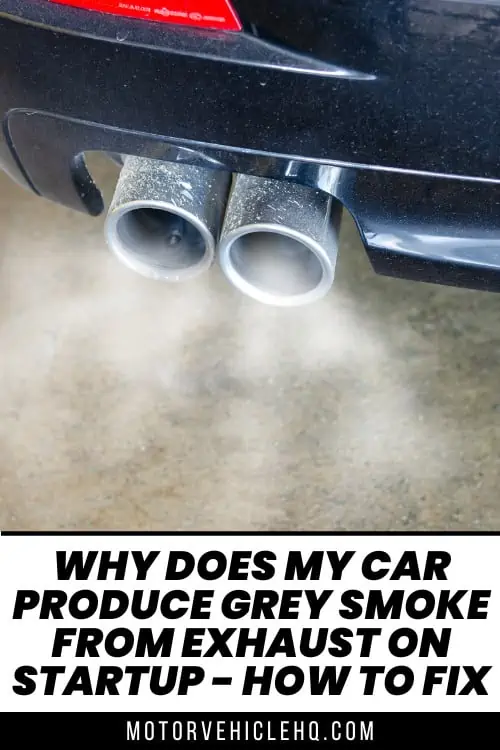

Jim Wicks is the founder of MotorVehicleHQ. With over two decades of experience in the automotive industry and a degree in Automotive Technology, Jim is a certified car expert who has worked in various roles ranging from a mechanic, car dealership manager, to a racing car driver. He has owned more than 20 cars over the past 15 years. Ask him about any vehicle you see on the road and he can tell you the make, model and year. He loves the aesthetics of all things cars, and keeps his vehicles in pristine condition.
In his free time, Jim enjoys getting his hands dirty under the hood of a classic car or taking long drives along the country roads. His favorite car? A 1967 Shelby GT500, a true classic that, according to Jim, “represents the pure essence of American muscle.”
